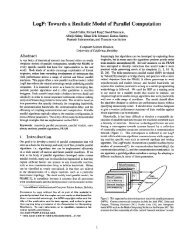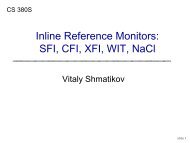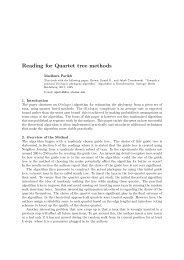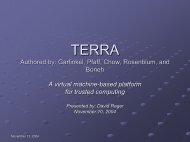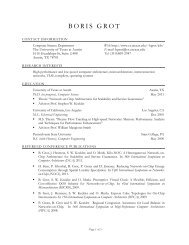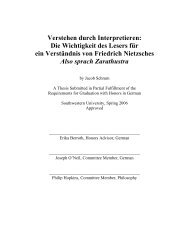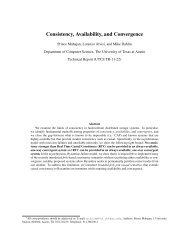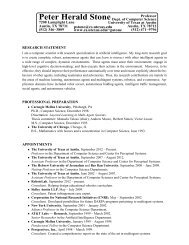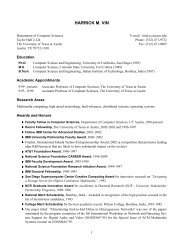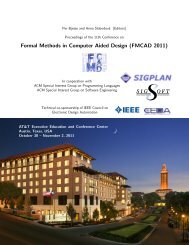A User's Guide to gringo, clasp, clingo, and iclingo
A User's Guide to gringo, clasp, clingo, and iclingo
A User's Guide to gringo, clasp, clingo, and iclingo
You also want an ePaper? Increase the reach of your titles
YUMPU automatically turns print PDFs into web optimized ePapers that Google loves.
2<br />
4.2.3 Problem Solution<br />
3<br />
3<br />
1<br />
3<br />
2<br />
6<br />
2<br />
1 2<br />
4<br />
Figure 6: A Minimum-Cost Round Trip.<br />
1<br />
4<br />
Finally, we explain how the unique minimum-cost round trip (depicted in Figure 6)<br />
can be computed. The catch is that we are now interested in optimal answer sets, rather<br />
than in arbitrary ones. In order <strong>to</strong> determine the optimum, we can start by gradually<br />
decreasing the costs associated <strong>to</strong> answer sets until we cannot find a strictly better one<br />
anymore. <strong>clasp</strong> (or <strong>clingo</strong>) enumerates successively better answer sets w.r.t. the<br />
provided optimization statements (cf. Section 3.1.11). Any answer set is printed as<br />
soon as it has been computed, <strong>and</strong> the last one is optimal. If there are multiple optimal<br />
answer sets, an arbitrary one among them is computed. For the graph in Figure 5, the<br />
optimal answer set (cf. Figure 6) is unique, <strong>and</strong> its computation can proceed as follows: To compute the minimum-cost<br />
Answer: 1<br />
cycle(1,3) cycle(2,4) cycle(3,5) \<br />
cycle(4,1) cycle(5,6) cycle(6,2)<br />
Optimization: 13<br />
Answer: 2<br />
cycle(1,2) cycle(2,5) cycle(3,4) \<br />
cycle(4,1) cycle(5,6) cycle(6,3)<br />
Optimization: 11<br />
5<br />
2<br />
2<br />
2<br />
round trip for the graph in Figure<br />
5, invoke:<br />
<strong>gringo</strong> \<br />
\<br />
| \<br />
<strong>clasp</strong> -n 0<br />
or alternatively:<br />
<strong>clingo</strong> -n 0 \<br />
\<br />
Given that no answer is obtained after the second one, we know that 11 is the optimum<br />
value, but there might be more optimal answer sets that have not been computed<br />
yet. In order <strong>to</strong> find them <strong>to</strong>o, we can use the following comm<strong>and</strong> line options of<br />
<strong>clasp</strong> (cf. Section 5.4): “--opt-value=11” in order <strong>to</strong> initialize the optimum<br />
<strong>and</strong> “--opt-all” <strong>to</strong> compute also equitable (rather than only strictly better) answer<br />
sets. After obtaining only the second answer given above, we are sure that this is the The full invocation is:<br />
unique optimal answer set, whose associated edge costs (cf. Figure 6) correspond <strong>to</strong> <strong>gringo</strong> \<br />
\<br />
the reported optimization value 11. Note that, with #maximize statements in the<br />
| \<br />
input, this correlation might be less straightforward because they are compiled in<strong>to</strong> <strong>clasp</strong> -n 0 \<br />
#minimize statements in the process of generating lparse’s output format [53]. --opt-value=11 \<br />
Furthermore, if there are multiple optimization statements, <strong>clasp</strong> (or <strong>clingo</strong>) will --opt-all<br />
or alternatively:<br />
report separate optimization values ordered by significance. Finally, the two-stage in- <strong>clingo</strong> -n 0 \<br />
vocation scheme exercised above, first determining the optimum <strong>and</strong> afterwards all --opt-value=11 \<br />
(<strong>and</strong> only) optimal answer sets, is recommended for general use. Otherwise, if using --opt-all \<br />
option “--opt-all” right away without knowing the optimum, one risks the enumer-<br />
\<br />
36



